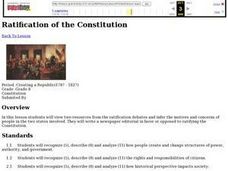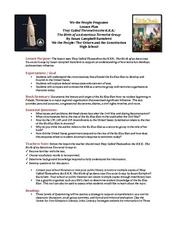Curated OER
Changes In The New Nation: New Beginnings
Students consider the role of American newspapers in the revolution and plans for new government. In this early American history instructional activity, students determine how communication provided by newspapers contributed to the...
Curated OER
Search & Seizure Opinion Poll
Students examine federal and state constitutional law relating to search and seizure. They analyze various scenarios, participate in an opinion poll, and discuss difficulties in balancing individual privacy rights with the need to fight...
Curated OER
"Martial Law in Hawaii After the Attack on Pearl Harbor"
Students explore the concepts of martial law, writ of habeas corpus, due process, discovery and human and constitutional rights during World War II. They assess the roles and responsibilities of government leaders and citizens during...
Curated OER
The Constitution
Students determine that the rules that we follow in America were written in the Constitution. They study a copy of the constitution and discuss how it compares and differentiates from the plan the class has written. They recite our...
Curated OER
Second Graders Create Their Own Social Studies Book (Part I, The 5Ws of the Constitution)
Students study the United States Constitution and create a year-long cumulative activity for social studies. In this social studies lesson, students complete activities throughout the year to learn the 5Ws for the United States...
Curated OER
Ratification of the Constitution
Eighth graders view two resources from the ratification debates and infer the motives and concerns of people in the two states involved. They write a newspaper editorial in favor or opposed to ratifying the Constitution.
Curated OER
Utah's Legislative Branch: How a Bill Becomes a Law
Seventh graders explain the steps by which a bill becomes a law. They research how a bill becomes a law within the three branches of Utah's government and synthesize their research and discussion in a classroom representation of government.
Deliberating in a Democracy
Marriage and the State
What defines marriage in society? Scholars investigate the moral and legal arguments of what defines marriage. They analyze different marriage traditions and social customs around the world along with Supreme Court decisions. Individuals...
Heritage Foundation
The Powers of the Executive
Are executives as powerful as they sound? High schoolers find out about the US president and executive branch. A variety of activities include scaffolded reading sections, research assignments, and collaborative group work.
American Bar Association
What Is Separation of Powers?
Who has the power? Scholars investigate the creation of the three branches of government in the United States Constitution. They analyze just why the framers created the branches the way they did.
C-SPAN
Judicial Review and Marbury v Madison
The Supreme Court case Marbury v. Madison may not be widely recognized but the landmark case is particularly significant because it established the precedent for judicial review and that the Supreme Court had power as an interpreter of...
Curated OER
The Called Themselves the K.K.K.; The Birth of an American Terrorist Group
How did Ku Klux Klan develop and flourish in the US? How did the government respond to acts of terrorism conducted by the KKK following the Civil War? How does the government respond to acts of terrorism today? This resource...
Judicial Branch of California
The Power of the Press: The First Amendment
Was what happened in 1886 at the Haymarket riot a crime or a case of xenophobia? Using political cartoons from the time, young historians consider the role the media played in anti-labor sentiment during the time and how that influenced...
Walt Disney Company
Elizabeth Started All the Trouble
Elizabeth Cady Stanton was a famous suffragette that paved the way for equal rights for women. Readers respond to before, during, and after reading questions based on her story. The resource is a great addition to a lesson during...
Judicial Learning Center
Getting Ready for Trial
A courtroom can be a scary place for the uninitiated. Get familiar with the process using a helpful overview of the activities that take place prior to both civil and criminal cases. The lesson explains the differences between...
National Endowment for the Humanities
Background on the Patriot Attitude toward the Monarch
Learners explain the Patriot attitude toward the British monarchy, which helps them embrace the Founders' reluctance to have a strong executive under the Articles of Confederation as well as their desire to build in checks of executive...
Curated OER
The Bill of Rights is a-Rockin
Students explore the U.S. Constitution through music. In this Bill of Rights instructional activity, students discuss a hypothetical case regarding lyrics by Madonna and the historical Massachusetts Blue Laws. Students use the Bill of...
Curated OER
The First Amendment: Freedom of Expression
Young scholars explore First Amendment rights. In this U.S. Constitution lesson plan, students examine the freedom of expression as they view a PowerPoint presentation and listen to the lecture that accompanies it.
Curated OER
Bill of Rights and Lawmaking
Ninth graders consider how the Bill of Rights impacts the lawmaking process in the United States. In this Bill of Rights lesson, 9th graders discuss the amendments and their limitations. Students research the role of the Legislative...
Curated OER
Obama Hope Poster
Students consider constitutional rights. In this Bill of Rights lesson, students complete an activity guide regarding the property rights regarding the Obama "Hope" poster. Students respond to discussion questions pertaining to the topic.
Curated OER
Citizen Juries: Zacarias Moussaoui - May 1, 2006
Students consider deliberations by juries. In this citizen jury lesson, students complete readings regarding the constitutional right to a trial by jury as well as on the civic responsibility to serve on a jury.
Curated OER
Supreme Court June 2010 Decisions Wrap-Up
High schoolers consider constitutional rights. In this Bill of Rights lesson, students complete an activity guide that requires high schoolers to examine Bill of Rights-related cases of 2010. Students respond to discussion questions...
Curated OER
Know Your (copy)Rights
Students define public domain and provide examples of work in the public domain. They define copyright, provide examples of copyrighted materials, and state the procedure for securing copyright for their own work
Curated OER
Rock the Vote
Students dramatize the process by which a bill becomes a law. They design a product that explains the function of the Legislative Branch in government and present their work to the class.

























